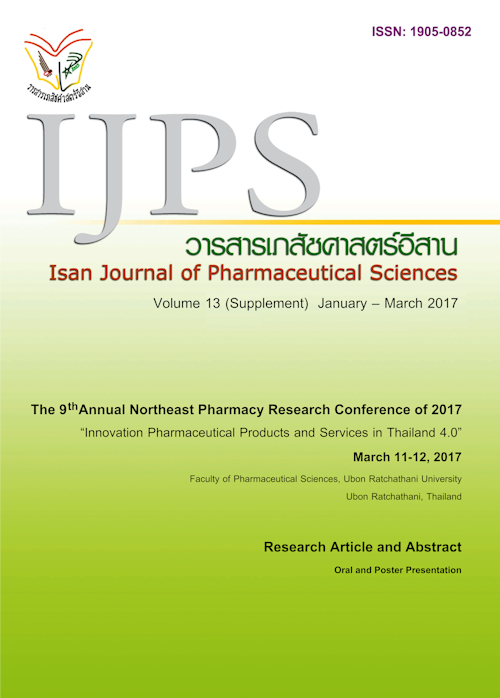Investigation of skin penetration enhancing mechanism of limonenecontaining liposome entrapped hydrophilic compound
Main Article Content
Abstract
Introduction: Penetration enhancer-containing liposome vesicles have been reported as a carriers for transdermal delivery of entrapped drug. The aim of this study was to investigate the
penetration enhancing mechanism of limonene-containing liposomes (LI) on the transdermal delivery of hydrophilic compound. Methods: NaFI was used as a model hydrophilic compound for loading into liposome vesicles. The physicochemical characteristics of liposome formulations were evaluated. The in vitro skin penetration study was performed by using Franz diffusion cells. Transmission electron microscopy (TEM) was used to observe the penetrated vesicles in the receiver medium. Fourier transform infrared spectroscopy (FTIR) was used to determine the modification of intercellular lipid organization of stratum corneum. Results: The physicochemical properties of LI showed smaller vesicle size (40.59 nm), higher entrapment efficiency, and higher membrane fluidity than liposomes without limonene. The skin penetration of NaFI-entrapped in LI was higher than non NaFI-entrapped in LI, NaFI-entrapped in liposomes without limonene, and NaFI solution, respectively. TEM image showed LI vesicles penetrated through skin into the receiver compartment. FTIR result of LI treated stratum corneum also exhibited high fluidity of intercellular lipid organization of stratum corneum barrier. Conclusion: The skin penetration enhancement of limonene-containing liposomes might result from LI as transdermal carriers to deliver the entrapped drug through skin. Moreover, limonene (as a penetration enhancer) provided the main modification in the stratum corneum barrier, leading to increase of skin penetration of hydrophilic compound.
Article Details
In the case that some parts are used by others The author must Confirm that obtaining permission to use some of the original authors. And must attach evidence That the permission has been included
References
Mura S, Manconi M, Sinico C, Valenti D, Fadda AM. Penetration enhancer-containing vesicles (PEVs) as carriers for cutaneous delivery of minoxidil. Int J Pharm, 2009, 380(1t2): 72-79.
Manconi M, Caddeo C, Sinico C, Valenti D, Mostallino MC, Biggio G, Fadda AM. Ex vivo skin delivery of diclofenac by transcutol containing liposomes and suggested mechanism of vesicle-skin interaction. Eur J Pharm Biopharm, 2011, 78(1): 27-35.
Dragicevic-Curic N, Scheglmann D, Albrecht V, Fahr A. Temoporfin-loaded invasomes: development, characterization and in vitro skin penetration studies. J Control Release, 2008, 127(1): 59-69.
El Maghraby GMM, Williams AC, Barry BW. Skin delivery of oestradiol from lipid vesicles: importance of liposome structure. Int J Pharm, 2000, 204(1t2): 159-169.
Jain S, Jain P, Umamaheshwari RB, Jain NK. Transfersomes--a novel vesicular carrier for enhanced transdermal delivery: development, characterization, and performance evaluation. Drug Dev Ind Pharm, 2003, 29(9): 1013-1026.
Badran M, Shazly G, El-Badry M. Effect of terpene liposomes on the transdermal delivery of hydrophobic model drug, nimesulide: Characterization, stability and in vitro skin permeation. Afr J Pharm Pharmacol, 2012, 6: 3018-3026.
Subongkot T, Ngawhirunpat T. Effect of liposomal fluidity on skin permeation of sodium fluorescein entrapped in liposomes. Int J Nanomedicine, 2015, 10: 4581-4592.
Touitou E, Dayan N, Bergelson L, Godin B, Eliaz M. Ethosomes novel vesicular carriers for enhanced delivery: characterization and skin penetration properties. J Control Release, 2000, 65(3): 403-418.
Cevc G., Blume G. Lipid vesicles penetrate into intact skin owing to the transdermal osmotic gradients and hydration force. Biochimica et Biophysica Acta (BBA)! Biomembranes, 1992, 1104(1): 226-232.
Honeywell-Nguyen PL, Bouwstra JA. Vesicles as a tool for transdermal and dermal delivery. Drug Discov Today Technol, 2005, 2(1): 67-74.
Rangsimawong W, Opanasopit P, Rojanarata T, Ngawhirunpat T. Terpene-Containing PEGylated Liposomes as Transdermal Carriers of a Hydrophilic Compound. Bio Pharm Bull, 2014, 37(12): 1936t1943.


